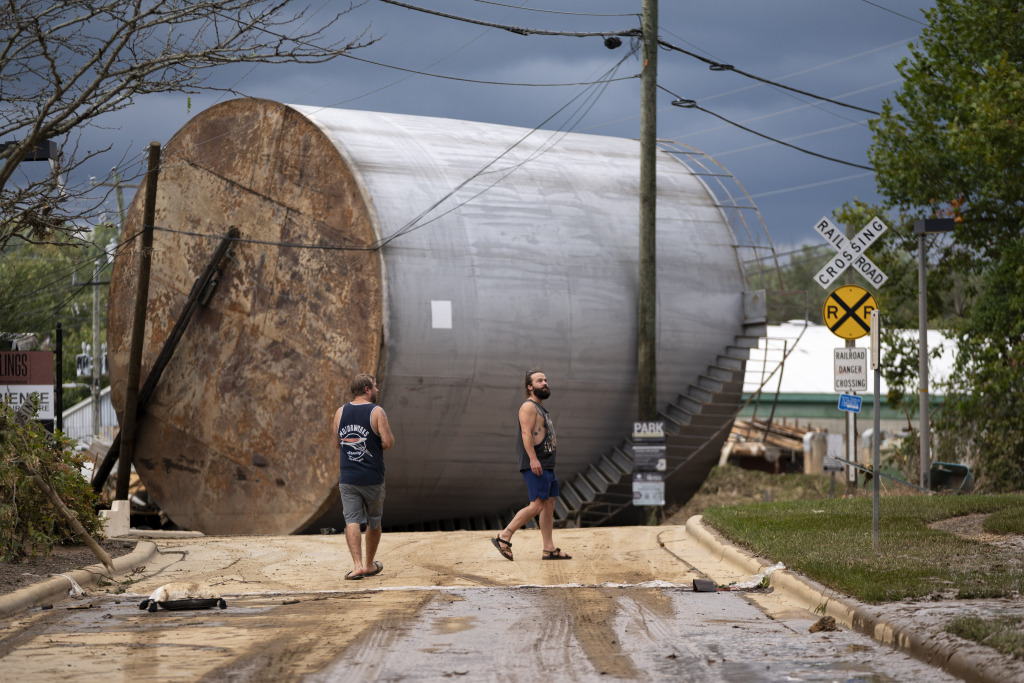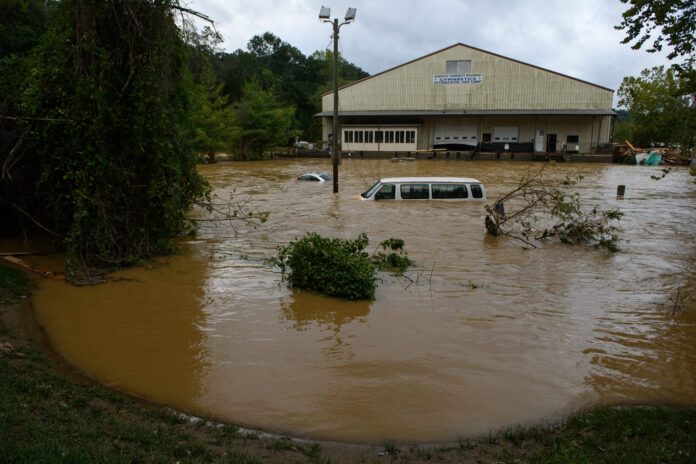Desperate residents in western North Carolina, cut off by washed-out roads and lacking power and cellular service, lined up on Monday for fresh water and to send messages to loved ones confirming their safety, days after Hurricane Helene devastated the Southeastern U.S., killing more than 100 people.
Government officials and aid organizations scrambled to deliver basic supplies by airlift, truck, and mule to Asheville and its surrounding mountain communities. At least 121 deaths across six states were attributed to the storm — a toll that rose on Monday as the scale of the destruction became clearer, affecting an area from Florida’s Gulf Coast to the Appalachian Mountains in Virginia. In North Carolina, Asheville’s county alone reported at least 35 fatalities, with additional deaths in Georgia and South Carolina.
North Carolina Governor Roy Cooper predicted the death toll would rise as emergency responders gained access to areas isolated by collapsed roads, damaged infrastructure, and widespread flooding. Many primary routes into Asheville were washed out or blocked by mudslides, including Interstate 40, and the city’s water system sustained major damage, forcing residents to collect creek water for basic needs like flushing toilets.

How Some of the Worst-Hit Areas Are Coping
In one neighborhood, where a wall of water uprooted trees and left a muddy wasteland, residents shared food, water, and solace. “That’s the blessing in all this,” said Sommerville Johnston outside her powerless home, where she planned to make venison stew from her freezer before it spoiled. “Just bring your bowl and spoon,” she said
Elsewhere, people lined up for over a block at Mountain Valley Water to fill containers of all types. Derek Farmer, who brought three gallon-sized apple juice jugs, said he had prepared for the storm but was growing anxious after three days without water. “I just didn’t know how bad it was going to be,” he said.
Officials warned that rebuilding from the widespread destruction of homes and property would be a lengthy and challenging process. The storm turned life upside down across the Southeast, with deaths also reported in Florida and Virginia. Video footage showed debris, including overturned boats and splintered docks, strewn across Lake Lure, a picturesque spot outside Asheville.
Helene made landfall in northern Florida late Thursday as a Category 4 hurricane, rapidly moving through Georgia, the Carolinas, and Tennessee with torrential rains that caused widespread flooding. The Federal Emergency Management Agency (FEMA) reported on Monday that hundreds of roads remained closed across western North Carolina, and shelters were housing over 1,000 displaced people.
Governor Cooper urged residents to avoid travel for their own safety and to keep roads clear for emergency vehicles. More than 50 search teams fanned out across the region to locate those stranded.
Waiting for Help and Searching for a Signal
In Asheville, several dozen residents gathered on high ground on Monday, hoping to find one of the city’s rarest commodities — a cell signal. Some texted friends and loved ones with a simple message: “I’m OK.”
“Is this day three or day four?” Colleen Burnet asked. “It’s all been a blur.”
North Carolina experienced its worst flooding in a century. Rainfall estimates in some areas surpassed two feet (61 centimeters) since Wednesday. President Joe Biden pledged federal support to the survivors and others affected across the Southeast for “as long as it takes.” He planned to ask Congress for additional disaster assistance funds and intended to visit North Carolina later in the week.
FEMA Administrator Deanne Criswell joined Governor Cooper on Monday to assess the damage. Federal search-and-rescue teams and nine additional units were en route, while food and water arrived by truck and cargo planes.
Volunteers were stepping in as well. Mike Toberer brought a dozen mules to deliver supplies to hard-to-reach mountainous areas. “We’ll take our chainsaws and push those mules through,” he said, explaining that each mule could carry up to 200 pounds (90 kilograms) at a rate of 2 mph (3.2 kph).
Why Western North Carolina Was Hit So Hard
Western North Carolina suffered more severe damage due to the interaction of Helene’s remnants with the Appalachian Mountains’ higher elevations and cooler air, which led to even heavier rainfall. Many communities, including Asheville, are built in valleys, making them particularly vulnerable to flooding. Furthermore, the ground was already saturated before Helene’s arrival, noted National Weather Service meteorologist Christiaan Patterson
“By the time Helene came into the Carolinas, we already had that rain on top of more rain,” Patterson said. Climate change has exacerbated the conditions that fuel such storms, allowing them to rapidly intensify in warming waters and become powerful cyclones within hours.
Destruction From Florida to Virginia
In Florida, several feet of water flooded the Clearwater Marine Aquarium, forcing staff to relocate two manatees and sea turtles. Although all animals were safe, much of the aquarium’s critical equipment was damaged, said James Powell, the executive directo
Georgia Governor Brian Kemp reported widespread devastation, saying the storm “literally spared no one.” Most of Augusta, a city of approximately 200,000 near the South Carolina border, remained without power on Monday. Kemp and other officials reassured residents that they understood their plight.
With at least 25 fatalities in South Carolina, Helene was the deadliest storm to strike the state since Hurricane Hugo in 1989, which killed 35 people.
Tropical Storm Kirk Forms
On Monday, Tropical Storm Kirk formed in the eastern Atlantic Ocean, and the U.S. National Hurricane Center projected that it could develop into a “large and powerful hurricane” by Tuesday night or Wednesday. The storm was located about 700 miles (1,125 kilometers) west of the Cabo Verde Islands with sustained winds of 45 mph (70 kph), though it posed no immediate threat to land.


